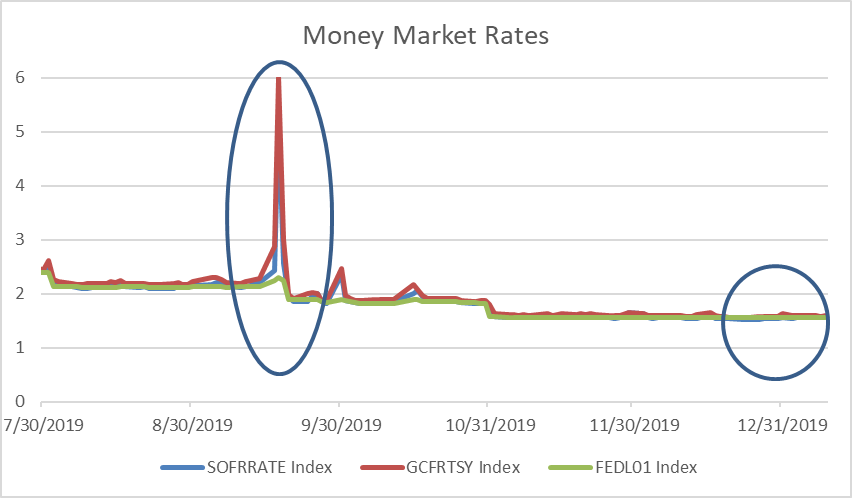
Updating the Overnight Liquidity Paradigm
The 2019 mid-September liquidity squeeze in overnight repo markets was perhaps the single most noteworthy event in the cash markets last year. As we noted at the time, the event posed major questions about the post-crisis banking regime and its impact on banks’ ability to lend out reserves. It also asked important questions of the Fed, namely whether it had the capacity to prevent wild fluctuations in money market funds during periods when liquidity is stretched.
Since September 2019, the Fed has provided a reminder of its capabilities, all but squashing out volatility in the near-term. It did this simply by pumping the system full of cash, adding nearly $500 billion in liquidity into the market over year-end via a combination of asset-purchases and repo operations (both overnight and term). The result was that short-term rates were relatively stable over the time period, even as dealers faced the usual constraints regarding window-dressing at year-end.
Figure 1: Money Market Fund Rates

Source: Bloomberg
By undertaking these actions, the Fed proved to the market that it has control over the situation, that it is at the proverbial “wheel.” However, in the process, the Fed also put itself in the uncomfortable position of having to undo many of its earlier actions.
Start with the balance sheet. Prior to the liquidity crunch, the Fed had expressed a desire to draw down its balance sheet in an effort to remove accommodation and “normalize” monetary policy. It effectively engaged in reverse QE, allowing some $700 billion in bonds to run off between the period of October 2017 and August 2019. The liquidity operations have effectively undone these actions, adding $350 billion in assets back onto the balance sheet. This has left Chair Powell and others in the awkward position of stating that these asset purchases are “not QE,” even as operationally they are very much the same.
Perhaps more importantly, the Fed is also now signaling that it does not want to keep acting as a player in the repo market. Demand for its facilities remains strong, with the most recent auctions putting out $83 billion in liquidity. Nevertheless, board members, such as Vice Chair Richard Clarida, have expressed a desire to “transition away from active repo operations this year” once reserves have reached an “ample level.” The issue here is that, as the September 2019 liquidity crunch showed, the Fed is not very good at estimating the required level of reserves.
As a result, it seems likely that the Fed will need to continue its repo operations until demand for them has completely dried up. Furthermore, it’s also conceivable that in order to stamp out future volatility, the Fed will need to implicitly guarantee that it will re-intervene in times of stress. If not, a surge in the demand for reserves could once again lead to funding shortages, resulting in a spike in rates.
A Possible Long-Term Solution
As former NY Fed chief Bill Dudley noted, the most straightforward solution to this problem is to transition the temporary repo facility to a permanent one. This would help ensure that banks always have access to additional reserves, which in turn would trigger several knock-on effects.
First off, it would allow the banks to operate with lower structural reserve levels, which would in turn translate to a smaller Fed balance sheet. Secondly, it would remove the need for the Fed to estimate the demand for reserves at any given point. The Fed would no longer have to calibrate its balance sheet on an ad hoc basis to account for changes in reserve demand, since this would happen automatically as banks used the repo facility. Thirdly, the facility would alleviate concerns over liquidity on the short end. During a liquidity crunch when market rates spike, banks would be incentivized to borrow reserves from the Fed and in turn lend them out to their counterparties. Theoretically, this would continue until demand for liquidity has been satisfied and market rates have fallen back below the rate offered by the Fed.
There are some concerns with this solution. It would require the Fed to maintain an active presence in the short-term markets, something it has not done since before the crisis. It would also have to determine how broad its counterparty list would be (e.g. would it include any non-bank institutions such as money funds?). And finally, it could lead to banks being more aggressive in their liquidity management.
Even so, the benefits here seem to outweigh the risks. Repo facilities similar to the one proposed are used by a variety of central banks (including the Bank of Canada) and have proven to be broadly successful in controlling short-term rates. Nevertheless, given the Fed’s conservative nature and its recent success in stamping out volatility, it will likely take a considerable amount of time to determine whether it wants to transition from temporary to permanent solutions.
Our research is for personal, non-commercial use only. You may not copy, distribute or modify content contained on this Website without prior written authorization from Capital Advisors Group. By viewing this Website and/or downloading its content, you agree to the Terms of Use.
Please click here for disclosure information: Our research is for personal, non-commercial use only. You may not copy, distribute or modify content contained on this Website without prior written authorization from Capital Advisors Group. By viewing this Website and/or downloading its content, you agree to the Terms of Use & Privacy Policy.
